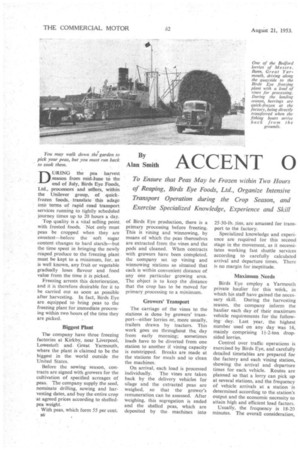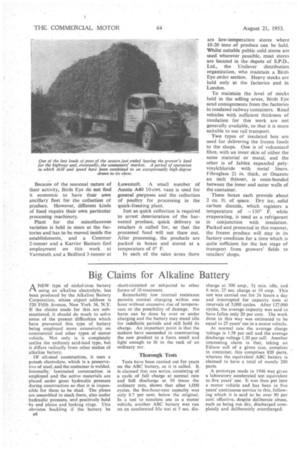ACCENT 0 PEED
Page 40

Page 41

Page 42

If you've noticed an error in this article please click here to report it so we can fix it.
By Alan Smith
DuRING the pea harvest season from mid-June to the end of July, Birds Eye Foods, Ltd., processors and sellers, within the Unilever group, of quickfrozen foods., -translate this adage into terms of rapid road transport services running to tightly scheduled journey times up to 20 hours a day.
Top quality is a vital selling point with frosted foods. Not Only must peas be cropped when they are sweetest—before the soft sugar content changes to hard starch—but the time spent in bringing the newly reaped produce to the freezing plant must be kept to a minimum, for, as is well known, any fruit or vegetable gradually loses flavour and food value from the time it is picked.
Freezing arrests this deterioration, and it is therefore desirable for it to be carried out as soon as possible after harvesting. In fact, Birds Eye are equipped to bring peas to the freezing plant for immediate processing within two hours of the time they are picked. .
Biggest Plant
The company have three freezing factories at Kirkby, near Liverpool, Lowestoft and• Great Yarmouth, where the plant is claimed to be the biggest in the world outside the United States.
Before the sowing season, contracts are signed with growers for the cultivation of specified acreages of peas. The company supply the seed, nominate drilling, sowing and harvesting dates, and buy the entire crop at agreed prices according to shelledpea weight.
With peas, which form 55 per cent. B6 of Birds Eye production, there is a primary processing before freezing. This is vining and winnowing, by means of which the peas themselves are extracted from the vines and the pods and cleaned. When contracts with growers have been completed. the company set up vining and winnowing stations so situated that each is within convenient distance of any one particular growing area. The object is to keep the distance that the crop has to be moved for primary processing to a minimum.
Growers' Transport
The carriage of the vines to the stations is done by growers' transport—either lorries or, more usually, trailers drawn by tractors. This work goes on throughout the, day from early morning; sometimes loads have to be diverted from one station to another if vining capacity is outstripped. Breaks are made at the stations for meals and to clean the machines.
On arrival, each load is processed individually. The vines are taken back by the delivery vehicles for silage and the extracted peas are weighed, so that the grower's remuneration can be assessed. After weighing, this segregation is ended and the shelled peas, which are deposited by the machines into 25-30-1b. ,tins, are amassed for transport to the factory.
Specialized knowledge and experience are required for this second stage in the movement, as it necessitates working fast shuttle services according to carefully calculated arrival and departure times, There is no margin for ineptitude,
Maximum Needs
Birds Eye employ a Yarmouth private haulier for this work, in which his staff have gained the necessary skill. During the harvesting season, the company inform the haulier each day of their maximum vehicle requirements for the followingday. Last year, the highest number used on any day was 16, mainly comprising 11-2-ton dropsided lorries.
Control over traffic operations is exercised by Birds Eye, and carefully detailed timetables are prepared for the factory and each vining station, showing the arrival and departure times for each vehicle. Routes are planned so that a lorry can pick up at several stations, and the frequency of vehicle arrivals at a station is determined according to the station's output and the economic necessity to attain high and efficient load factors.
Usually, the frequency is 18-20 minutes. The overall consideration, of course, is to limit the factory intake to the capacity of the plant, which, during the season, is worked throughout the 24 hours.
Schedules are checked • against actual timings by superintendents at the arrival points, and at the factory, 15-20 minutes are allowed for turnround. Sterilized empty tins are taken to the vining stations on the outward journeys. At Yarmouth, last year, the first loads arrived at 7.15 a.m. and the last at 3.25 a.m. the following day, involving the clearance of 124 vehicles throughout the working period.
Green beans are the next most important crop to Birds Eye and are collected in a manner similar to that of peas, except that there are direct hauls from growers' beds to the factories, as no primary processing is necessary. The beans are picked and packed into bags for transport.
Fruits such as raspberries and strawberries are delivered for quick-freezing in suitable containers during their seasons. Herrings are also frozen at Yarmouth during the landing season. The factory is on the quayside. Because of the seasonal nature of their activity, Birds Eye do not find it economic to have their own ancillary fleet for the collection of produce. However, different kinds of food require their own particular processing machinery.
Plant for the miscellaneous varieties is held in store at the factories and has to be moved inside the establishments, and a Commer 2-tormer and a Karrier Bantam find employment on this work at Yarmouth and a Bedford 3-tonner at Lowestoft. 'A small number of Austin A40 10-cwt. vans is used for general purposes and the collection of poultry for processing in the quick-freezing plant.
Just as quick collection is required to arrest deterioration of the harvested produce, quick delivery to retailers is called for, so that the processed food will not thaw out. After processing, the products are packed in boxes and stored at a temperature of 0° F.
In each of the sales areas there
are low-temperature stores where 10-20 tons of produce can be held. Whilst suitable public cold stores are used wherever possible, most stores are located in the depots of S.P.D., Ltd., the Unilever distribution organization, who maintain a Birds Eye order section. Heavy stocks are held only at the factories and in London.
To maintain the level of stocks held in the selling areas, Birds Eye send consignments from the factories in insulated railway containers. Road. vehicles with sufficient thickness of insulation for this work are not generally available, so that it is more suitable to use rail transport
Two types of insulated box are used for delivering the frozen foods to the shops. One is of vulcanized fibre, with an inner skin of either the same material or metal, and the other is of Jablex expanded polyvinylchloride with metal liners. Fibreglass 2f. in. thick, or Onazote an inch thinner, is resin-bonded between the inner and outer walls of • the container.
These boxes each provide about 2 Cu. ft. of space. Dry ice, solid carbon dioxide, which registers a temperature of —130° F. while evaporating, is used as a refrigerant
in conjunction with insulation. Packed and protected in this manner, the frozen produce will stay in its factory condition for a time which is quite sufficient for the last stage of transport from growers' fields to retailers' shops.




























































































